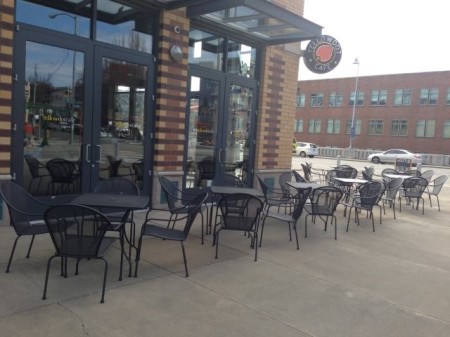Ashley Portilla, founder of District Fabric in Fremont, found herself at a crossroads when setting the employee wages at her newly opened business. Even one and a half years ago, talk of a $15 minimum wage for Seattle was in the air. Portilla decided that to attract good employees, she wanted to pay well, and made the choice to pay above the $15 an hour proposed wage, and well above Seattle’s then-minimum wage of $9.32.
When Seattle’s Minimum Wage Ordinance went into effect April 1st of this year small businesses with fewer than 500 employees, like Portilla’s, were required to start paying their employees $11 per hour. This is the first phase-in of the new wage over the next few years.
Fremont hosts a variety of businesses, including many restaurants and cafes along Fremont Avenue. Seattle’s new minimum wage law will affect different types of businesses in different ways. Image courtesy of Wikimedia Commons.Phil Megenhardt of the Fremont Chamber of Commerce Board of Directors acknowledges that “Fremont is home to a diverse business landscape.” There’s light industry, manufacturing, headquarters for Google and Adobe, and many restaurants and cafes. There are also small businesses that add to Fremont’s famous quirky character according Megenhardt.
“You’ve got all these people existing together in a very thriving neighborhood,” he observed.
Fremont has been wrestling with the new minimum wage since it was proposed over a year ago. In March 2014, businesses owners, members of the Fremont Chamber of Commerce and Seattle City Council Member Sally Clark met at Fremont’s Red Door to discuss the proposed change in wages, and how it might affect the many small businesses in Fremont.
At the meeting, president of the Washington Restaurant Association Anthony Anton said that businesses’ voices were being forgotten in the rhetoric around the $15 minimum wage, and pointed out that most restaurants in the WRA are small businesses with 20 employees or fewer.
Many small boutiques like the kind Portilla owns will not be affected by the change in law, because many of them already pay above $15 an hour, according to Megenhardt.
It’s the other types of businesses — the ones people walking through the neighborhood are less likely to notice — that may be most affected by the new wage law, said Megenhardt. One example is the Foss Maritime shipyard.
“On the light industry side, the challenge you’re facing is that a lot of the industry businesses in Fremont are competing on a global level. These guys are building ships that they sell all over the world,” Megenhardt said.
These types of industries will have to compete with lower overseas wages.
Another industry sector that is more likely to be affected by the wage increases are the service industries, including restaurants, cafes and barbershops. Megenhardt projects that prices will increase.
“The service industries are going to see that affect their pocketbook directly,” Megenhardt said.

Before the new change in minimum wage, the Yellow Dot Cafe started off its seven employees at $10 an hour and increased pay based on merit, according to manager Mary Malone. As a restaurant, the Yellow Dot can continue paying its employees $10 an hour under the new law as long as their total earnings, including tips and/or health benefits, add up to $11. Next year, the minimum wage will go up to $10.50 an hour with the total minimum compensation at $12. This will continue each year until 2021, when both minimum wage and minimum compensation will be locked in at $15 an hour.
The Foss shipyard in Seattle. Courtesy of The Herald of Everett.Malone said she hopes by the time this happens, the Yellow Dot will be thriving and have several new locations opened.
“[Otherwise] we’re going to have to raise our prices, and the customers aren’t going to like that,” Malone said. “If it had jumped straight to $15, we wouldn’t be able to stay open.”
Exactly how Fremont businesses will have to phase in the new minimum wage depends on the size of the business.
Large employers, such as Foss Shipyard, are required to pay $11 in minimum wage, to be increased over the next two years to $15. That is unless these businesses pay toward their employees’ health benefits, in which case wages will be phased in over three years, and reach $15 in 2018.
By Chetanya Robinson, UW News Lab

